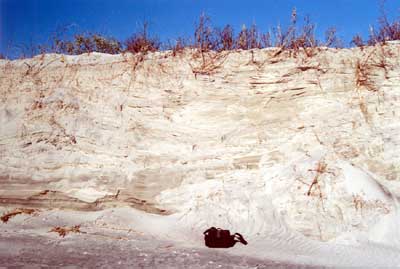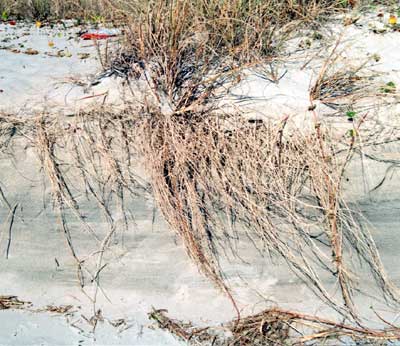 |
||
|
.... .The
presence of sand dunes directly landward of the beachface is extremely
important to the health of a coastline. The dune acts as a natural barrier
to stormwaves, protecting beachfront property and preventing washovers.
The stability and health of a coastline is directly tied to the stability
and health of its dunes. Without dunes the island is at the mercy of
the wind, waves and tides. |
||
 (click on image for higher resolution) |
||
| .....As
mentioned earlier, dunes are formed by the combination of wind and sand.
But blowing sand alone does not make a dune . For the blowing sand to
begin forming a dune it must come in contact with an obstruction in its
path. As the wind carring the sand passes the object it must increase
its velocity to keep up with the wind around it. Having cleard the obstruction,
the air pressure is reduces (this is known as the Bernoulli effect and
is the same effect that causes lift on airplane wings). This change in
air pressure causes eddy currents that deposit sand on the downwind side
of the dune. |
||
 Click
here to see animation
of the dune formation process. Click
here to see animation
of the dune formation process. |
||
| .....Vegetation is also important in duilding and maintaining dunes. So much so that some species are protected by laws which impose fines to anyone caught damaging the plants. The leaves of dune plants trap airborne sand, building the dune, while their extensive root systems help hold the dune together. The root systems help keep the dune sand from being blown away by the strong winds, but have little effect agianst the power of the waves. Below is an image of a dune scarp. Wave action has eroded the dune exposing the plant roots that had helped hold the dune together. | ||
 (click on image for higher resolution) |
||
| ......Certian types of plants are specialized for living on dunes. Sea Oats and American Beach Grass belong to this group. Both of these species have the ability to grow vertical runners that keep the green photosynthesizing leaves of the plants above the accumulating sand. Plants that do not have this specialization are soon buried by the shifting sands. Below in an image of a dune scarp exposing an american beach grass plant. Notice how tall the plant is from roots to leaves, compared to how much is visible at the surface. | ||
 (click on image for higher resolution) |
||